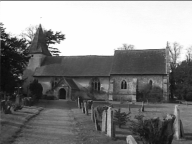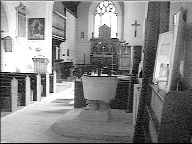![]()

![]()
7. All Saints, Farringdon

This beautiful village is tucked away off the A32 just south of Chawton. The large perfectly mown churchyard is dominated by huge yew and cedar trees. One of the yews is estimated to be an incredible 3,000 years old and a Latin certificate, signed by David Bellamy, hangs in the church to prove it. A second yew is a mere 1,000 years old. Both are hollow and brides and christened children are often photographed in the tree. The lovely cedars of Lebanon, now storm damaged, were brought back from the Middle East by a Rector in Victorian times.
The church is entered via a brick porch dated 1634 but the old oak door is fourteenth century and looks it. Inside the nave appears rather cold with its white-washed walls and bare floor. The medieval font is a large cylindrical bowl standing on a low pedestal of four 12th century fluted capitals. The pulpit is Georgian and was used by Gilbert White the famous naturalist, who was curate here for forty years, riding over from his house at Selbourne. One of his entries in the church register comments "Boyes playing in Farringdon churchyard — ejected." Jane Austen, a friend of the Rector John Benn, often worshipped here. Ludovic Kennedy the writer and broadcaster, lived here as a child. The altar rail is dedicated to the memory of his father, Captain E.C.Kennedy R.N. who was killed whilst commanding HMS Rawalpindi in November 1939 when it was sunk by the German battle cruisers Scharnhorst and Gneisenau in the North Atlantic whilst defending a convoy.

The present chancel was rebuilt in 1858 in Tractarian Ritualist style. The Sanctuary floor has some rare encaustic tiles whilst the marble altar furnishings are from Florence. In 1986 in the roof space over the west wall of the nave a 14th century wall painting was discovered of a Doom or Last Judgement.
One extraordinary record relating to the church is mentioned in the Guinness Book of Records. John Benn was appointed Rector in 1797 and remained in office for 60 years. His successor Thomas Massey only resigned in 1919. Thus only two Rectors spanned 122 years from the French Revolutionary Wars until after the First World War.
In the churchyard there is a Georgian preaching Cross. There is also an interesting old tombstone commemorating Mary Windebank, aged 75 years, who was dragged from her bed and murdered in 1758 for the money she had hidden beneath it. This scene is depicted on the tombstone with the Devil laughing behind.
Finally notice the 13th century church tower with its narrow splayed lancets in the north, south and west walls, surmounted by an attractive 'splay-foot' spire similar to those of the Hundred Years War period in Northern France.
Country Churches written by John Symonds
![]() return to the April 1997 features page
return to the April 1997 features page
![]() return to Home page and main index
return to Home page and main index
page last updated 30 MARCH 1997